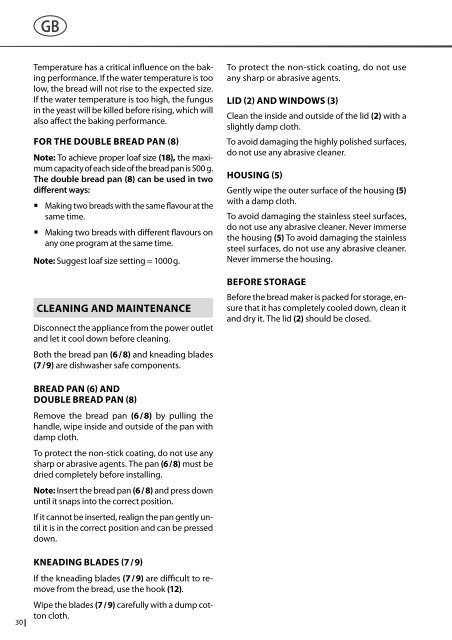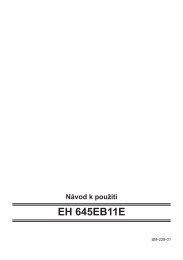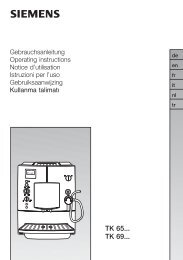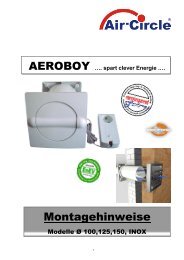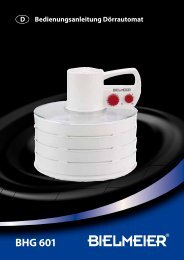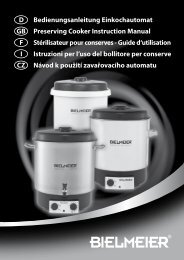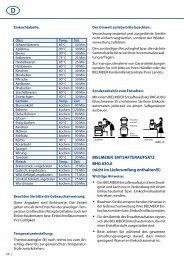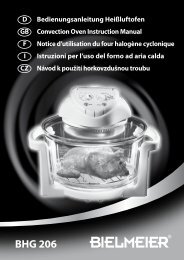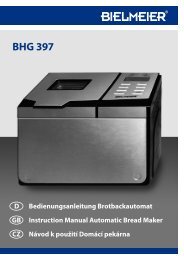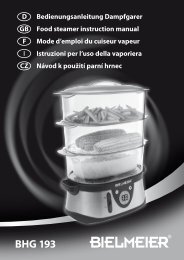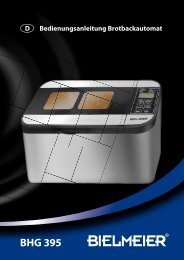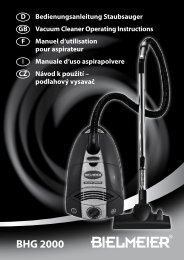You also want an ePaper? Increase the reach of your titles
YUMPU automatically turns print PDFs into web optimized ePapers that Google loves.
GB<br />
GB<br />
30<br />
Temperature has a critical influence on the baking<br />
performance. If the water temperature is too<br />
low, the bread will not rise to the expected size.<br />
If the water temperature is too high, the fungus<br />
in the yeast will be killed before rising, which will<br />
also affect the baking performance.<br />
For the double bread pan (8)<br />
Note: To achieve proper loaf size (18), the maximum<br />
capacity of each side of the bread pan is 500 g.<br />
The double bread pan (8) can be used in two<br />
different ways:<br />
• Making two breads with the same flavour at the<br />
same time.<br />
• Making two breads with different flavours on<br />
any one program at the same time.<br />
Note: Suggest loaf size setting = 1000 g.<br />
CLEANING AND MAINTENANCE<br />
Disconnect the appliance from the power outlet<br />
and let it cool down before cleaning.<br />
Both the bread pan (6 / 8) and kneading blades<br />
(7 / 9) are dishwasher safe components.<br />
Bread pan (6) and <br />
double bread pan (8)<br />
Remove the bread pan (6 / 8) by pulling the<br />
handle, wipe inside and outside of the pan with<br />
damp cloth.<br />
To protect the non-stick coating, do not use any<br />
sharp or abrasive agents. The pan (6 / 8) must be<br />
dried completely before installing.<br />
Note: Insert the bread pan (6 / 8) and press down<br />
until it snaps into the correct position.<br />
If it cannot be inserted, realign the pan gently until<br />
it is in the correct position and can be pressed<br />
down.<br />
Kneading blades (7/ 9)<br />
If the kneading blades (7 / 9) are difficult to remove<br />
from the bread, use the hook (12).<br />
Wipe the blades (7 / 9) care fully with a dump cotton<br />
cloth.<br />
To protect the non-stick coating, do not use<br />
any sharp or abrasive agents.<br />
Lid (2) and windows (3)<br />
Clean the inside and outside of the lid (2) with a<br />
slightly damp cloth.<br />
To avoid damaging the highly polished surfaces,<br />
do not use any abrasive cleaner.<br />
Housing (5)<br />
Gently wipe the outer surface of the housing (5)<br />
with a damp cloth.<br />
To avoid damaging the stainless steel surfaces,<br />
do not use any abrasive cleaner. Never immerse<br />
the housing (5) To avoid damaging the stainless<br />
steel surfaces, do not use any abrasive cleaner.<br />
Never immerse the housing.<br />
Before storage<br />
Before the bread maker is packed for storage, ensure<br />
that it has completely cooled down, clean it<br />
and dry it. The lid (2) should be closed.<br />
A LITTLE FOOD SCIENCE<br />
Flour<br />
Flour is the most important ingredient of your<br />
bread.<br />
• Bread flour, also called high-gluten flour, has a<br />
large amount of gluten and protein. It has good<br />
elasticity and can keep the bread from collapsing<br />
after it rises. Since the gluten content is<br />
higher than in common flour, it can be used to<br />
make large breads with better inner fibre. Bread<br />
flour is particularly suitable for making bread.<br />
• Plain flour is a mixture of soft and durum<br />
wheat. It is suitable for making cookies or quick<br />
breads.<br />
• Whole-wheat flour is ground from grain. It<br />
contains wheat skin and gluten. Whole-wheat<br />
flour is heavier and contains more nutrients<br />
than common flour.<br />
Since breads made with whole-wheat flour are<br />
usually smaller, many recipes combine wholewheat<br />
flour with bread flour to achieve the best<br />
result.<br />
• Black wheat flour, also called “rough flour”, is a<br />
kind of high-fibre flour that is similar to wholewheat<br />
flour. To achieve large size after rising,<br />
it must be used in combination with a high<br />
amount of bread flour.<br />
• Self-rising flour contains baking powder. It is<br />
used to make cakes, in particular.<br />
• Corn flour and oatmeal flour are ground from<br />
corn and oatmeal separately. These ingredients<br />
are added when making rough bread to enhance<br />
the flavour and texture.<br />
Sugar<br />
Sugar is a very important ingredient that increases<br />
the sweet taste and colour of bread. It is also<br />
considered nourishment in yeast bread. White<br />
sugar is widely used. Brown sugar, powder sugar,<br />
cotton sugar, syrup or honey may be called for in<br />
special instances.<br />
Note: Use only fine sugar. Gross grained sugar<br />
can damage the anti-adhesive layer of your bread<br />
pan.<br />
Note: Breads made without sugar will be smaller.<br />
Salt<br />
Salt is necessary to improve the flavour and crust<br />
colour. However, salt can also inhibit the rising of<br />
the yeast. Never use too much salt in a recipe.<br />
Note: Breads made without salt would be larger.<br />
Grease, butter and vegetable oil<br />
Grease can make bread softer and extend storage<br />
life. Butter should be melted or chopped to small<br />
pieces before using.<br />
Yeast<br />
After the rising process, the yeast will produce<br />
carbon dioxide. The carbon dioxide expands the<br />
bread and makes the inner fibre soften. However,<br />
fast breeding yeast needs the carbohydrates in<br />
sugar and flour as nourishment.<br />
1 tsp. active dry yeast = ¾ tsp. instant yeast<br />
1.5 tsp. active dry yeast = 1 tsp. instant yeast<br />
2 tsp. active dry yeast = 1.5 tsp. instant yeast<br />
Fresh yeast must be stored in the refrigerator, as<br />
the fungus in it will be killed at high temperature.<br />
Before using, check the production date and storage<br />
life of your yeast. Put it back in the refrigerator<br />
as soon as possible after each use.<br />
Note: When breads failt to rise, it is usually due<br />
to bad yeast.<br />
Follow the steps below to check if your yeast is<br />
fresh and active.<br />
1. Pour ½ cup warm water (45 – 50°C) into a<br />
measuring cup.<br />
2. Put 1 tsp. white sugar into the cup and stir;<br />
then sprinkle 2 tsp. yeast over the water.<br />
3. Place the measuring cup in a warm place for<br />
about 10 min. Do not stir the water.<br />
4. The mixture should foam up to 1 cup. Otherwise<br />
the yeast is dead or inactive.<br />
Baking powder<br />
Baking powder is used as a rising agent for UL-<br />
TRASCHNELL (ultra fast) breads and cakes. It does<br />
not need rise time, and it can produce air. Due to<br />
chemical processes, the air forms bubbles that<br />
soften the texture of the bread.<br />
31


